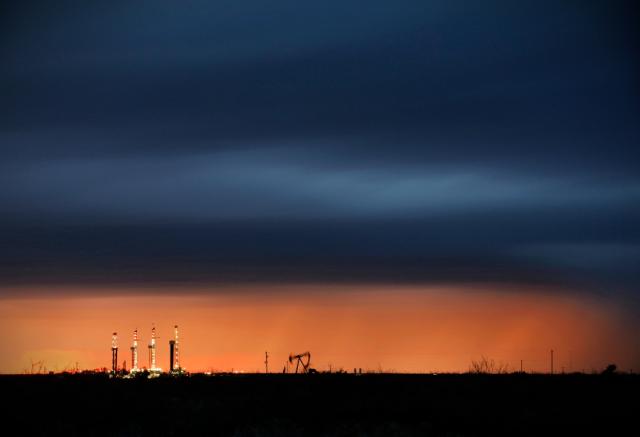
Value investors have been waiting for years to see if the broader market will rotate from growth to value. Could this help lift the dark clouds in energy? (Source: Hart Energy)
[Editor's note: A version of this story appears in the November 2019 edition of Oil and Gas Investor. Subscribe to the magazine here.]
Can market pessimism get any worse for the energy sector? Entering the first few days of the fourth quarter, the answer to the question was a clear, ‘Yes.’”
A weak ISM Manufacturing Index report of 47.8 sparked a two-day sell-off of over 800 points on the Dow Jones Industrial Average, and several flag-bearing E&P stocks fell to new 52-week lows—even after the XOP (S&P Oil & Gas Exploration & Production ETF) set an all-time low in August.
For example, EOG Resources Inc. dropped to $69.47 per share, down 48% from what was a 52-week high of $133.53. Diamondback Energy Inc. fell to $82.44 per share, down 41.4% from its 52-week high of $140.78.
As a reminder, an all-time low on the XOP was set in early August, when West Texas Intermediate (WTI) prices were in the low $50s per barrel (bbl). Earlier, the XOP had sustained higher levels, even when WTI prices slumped to $42.53 (Christmas Eve 2018) or $26.14/bbl (February 2016).
This disconnect reflects in part the broad market’s trend to funnel money into large-cap, momentum-driven tech stocks. (“Buy into strength, sell into weakness.”) But years of poor energy performance also played a key part. After the drone attack on Saudi Arabia’s oil facilities, one research firm questioned whether the events would “break the broader market momentum trade of short energy and long everything else.”
As it turned out, any XOP gains due to the bombing of the Khurais oil field and Abqaiq stabilization facilities evaporated in just days as Saudi Aramco announced moves to restore shipments to clients.
What may be the biggest cause for concern for E&Ps is the supply/demand imbalance looming in 2020.
In a mid-September report by Tudor, Pickering, Holt & Co., for example, the firm forecast non-OPEC 2020 liquids supply growth of 2.2 million barrels per day (MMbbl/d), outpacing by far demand growth of 1.25 MMbbl/d. Estimates of non-OPEC demand growth have tended to drift down as the trade war has continued. An early October survey showed a range of demand growth estimates of 0.8 to 1.5 MMbbl/d.
In addition to ongoing gains in U.S. production, global oil growth has been marked by some key offshore projects. Among them is Equinor’s Johan Sverdrup project in the North Sea, which started up in early October and is expected to ramp up from 200,000 to 440,000 bbl/d by next summer. Coupled with projects in Brazil and elsewhere, an “offshore surge” of 980,000 bbl/d is projected by Bernstein.
U.S. production growth is obviously a critical variable, especially against the backdrop of seasonally weak global demand in the first quarter. A report by Bernstein, issued prior to the bombing of Saudi Arabia’s infrastructure, forecast an oversupplied market through the first quarter, assuming U.S. producers reinvest 90% of cash flow at a WTI price of $60/bbl—or even just 80% at $50/bbl.
“We don’t like the oil macro situation into year-end,” said Bernstein, encouraging E&Ps to focus on hedging. But if low oil prices in the fourth quarter are an early indicator of seasonally weak first-quarter demand, can something similar be said about out-of-favor energy stocks discounting future prospects?
The equity strategy and quantitative research group of J.P. Morgan put a “Buy” recommendation on the energy sector in late September, citing its “depressed valuation and extreme bearish investor positioning.” In addition, “ongoing geopolitical tensions in the Middle East could help redirect flows into this universally hated and cheap sector.”
Most institutional investors have “abandoned the sector, with long-only portfolio managers holding below-benchmark sector exposure,” said J.P. Morgan. “Absolute and relative valuations are at lows, with small-cap E&Ps trading below book value and at price levels seen almost 25 years ago. In contrast, corporate sentiment is bullish, with insider purchases rising to cycle highs.”
The energy sector should be “a key beneficiary of stabilization/re-acceleration in the business cycle, which we expect to start playing out by early 2020 on global monetary and fiscal stimulus along with expectations of easing U.S.-China trade tension,” observed J.P. Morgan. Moreover, investors can get into most energy companies “at below pre-Saudi attack levels,” it added.
“The market should assign a structural premium to the equity-oil complex with the Middle East currently a geopolitical tinderbox,” continued the J.P. Morgan group, noting a preference for value stocks.
Value investing?
Value investors have been waiting for years to see if the broader market will rotate from growth to value. Could this help lift the dark clouds in energy?
Recommended Reading
US Drillers Cut Oil, Gas Rigs for Second Time in Three Weeks
2024-02-16 - Baker Hughes said U.S. oil rigs fell two to 497 this week, while gas rigs were unchanged at 121.
US Raises Crude Production Growth Forecast for 2024
2024-03-12 - U.S. crude oil production will rise by 260,000 bbl/d to 13.19 MMbbl/d this year, the EIA said in its Short-Term Energy Outlook.
To Dawson: EOG, SM Energy, More Aim to Push Midland Heat Map North
2024-02-22 - SM Energy joined Birch Operations, EOG Resources and Callon Petroleum in applying the newest D&C intel to areas north of Midland and Martin counties.
Santos’ Pikka Phase 1 in Alaska to Deliver First Oil by 2026
2024-04-18 - Australia's Santos expects first oil to flow from the 80,000 bbl/d Pikka Phase 1 project in Alaska by 2026, diversifying Santos' portfolio and reducing geographic concentration risk.
Comstock Continues Wildcatting, Drops Two Legacy Haynesville Rigs
2024-02-15 - The operator is dropping two of five rigs in its legacy East Texas and northwestern Louisiana play and continuing two north of Houston.



